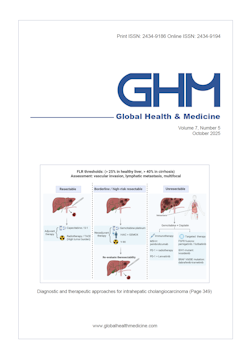Global Health & Medicine 2023;5(1):5-14.
Specific COVID-19 risk behaviors and the preventive effect of personal protective equipment among healthcare workers in Japan
Shimbashi R, Shiino T, Ainai A, Moriyama S, Arai S, Morino S, Takanashi S, Arashiro T, Suzuki M, Matsuzawa Y, Kato K, Hasegawa M, Koshida R, Kitaoka M, Ueno T, Shimizu H, Yuki H, Takeda T, Nakamura-Uchiyama F, Takasugi K, Iida S, Shimada T, Kato H, Fujimoto T, Iwata-Yoshikawa N, Sano K, Yamada S, Kuroda Y, Okuma K, Nojima K, Nagata N, Fukushi S, Maeda K, Takahashi Y, Suzuki T, Ohnishi M, Tanaka-Taya K
As coronavirus disease 2019 (COVID-19) outbreaks in healthcare facilities are a serious public health concern, we performed a case-control study to investigate the risk of COVID-19 infection in healthcare workers. We collected data on participants' sociodemographic characteristics, contact behaviors, installation status of personal protective equipment, and polymerase chain reaction testing results. We also collected whole blood and assessed seropositivity using the electrochemiluminescence immunoassay and microneutralization assay. In total, 161 (8.5%) of 1,899 participants were seropositive between August 3 and November 13, 2020. Physical contact (adjusted odds ratio 2.4, 95% confidence interval 1.1-5.6) and aerosol-generating procedures (1.9, 1.1-3.2) were associated with seropositivity. Using goggles (0.2, 0.1-0.5) and N95 masks (0.3, 0.1-0.8) had a preventive effect. Seroprevalence was higher in the outbreak ward (18.6%) than in the COVID-19 dedicated ward (1.4%). Results showed certain specific risk behaviors of COVID-19; proper infection prevention practices reduced these risks.
DOI: 10.35772/ghm.2022.01060







